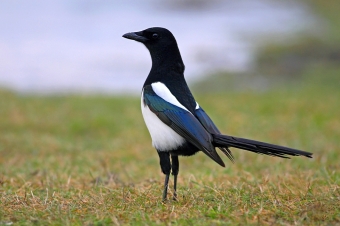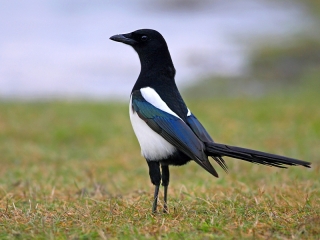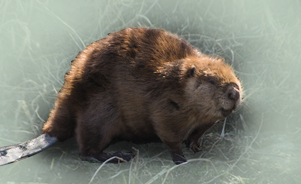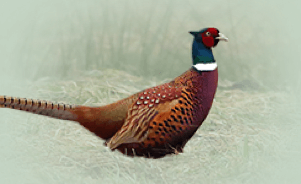Eurasian magpie or common magpie Pica pica

Features
The common magpie is a bird from the family of crows nesting throughout Europe, in much of Asia and northwestern Africa. Because it keeps to the vicinity of humans, it is large and has a striking pattern of colouring. It is one of the most easily recognisable species of birds in Europe.
| Species | Bird |
| Living space | Field, Meadow |
| Size | 44 - 46 cm |
| Weight | 180 - 270 g |
Description
The common magpie is a relatively large bird. It measures from 40 cm to half a meter, of which more than half (20 – 30 cm) can fall on its long tail. Its wingspan reaches 52 to 62 cm. Its body is black and white, with white areas on the chest, tail and bases of wings. White tips of the wings also become visible in flight - the primary flight feathers have a black edge and a white inner surface, so the tips of the folded wings appear black. The shiny black feathers around the rest of the body are not completely black. Depending on the angle of observation, they have a metallic green shine on the tail and wings, which depends on the age of the bird and the wear of the wings. The natural habitat of the common magpie includes open meadows with scattered bushes or trees, as well as forest edges and clearings in dense forests from the lowlands to the mountain belt. However, it also lives in cultural landscapes and parks; owing to its adaptability, it has become accustomed to living in settlements. It is an omnivore species; with a strong, sharp beak, with which it can dig into the ground for small invertebrates, pick fruit from the plants, hunt small birds and mammals, crush thorns, and so forth. In the periods of sufficient food, it often makes stocks within wells in the soil that it digs around its territory. Due to its adaptability in the last half of the century, it has successfully settled suburbs and, to a lesser extent, the city centres, where it has more food available throughout the year. The common magpie that digs in the rubbish and dump sites has become a common sight, even in the immediate vicinity of people. The common magpie’s intelligence has received a great deal of attention from animal behaviour researchers. Due to properties such as the use of tools, episodic memory and the ability to predict the actions of other members of the same species on the basis of its own experience, it is considered to be the most intelligent animal, and in this respect a competitor with some simians. Mirror self-recognition has also been demonstrated in European magpies, making them one of only a few species and the only non-mammalianl species to possess this capability.
Features Temenica (3)
SPECIAL ogr.




